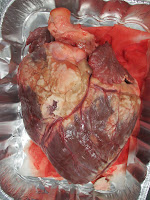
Who would have thought that a typically green leaf contains other pigments? Today in Biology 30 we extracted different pigments from a Coleus leaf. On the chromatogram you can see carotene, xanthophyll, chlorophyll a and chlorophyll b. Of course pigments are needs to capture sunlight to make glucose during photosynthesis!
We are studying the cardiovascular system in HS 20, and last class, we learnt that blood can be one of 4 main kinds:
Type A, Type B, Type AB, or Type O.
One's blood type is determined based on the presence or absence of antigen markers on the surface of their red blood cells. A simple test can be used to determine an unknown blood type. This is what we were doing in our lab activity today. :)




In HS 20 we recently completed a study of the Nervous System. Then we looked at two ailments of the Nervous System...concussions and FASD (Fetal Alcohol Spectrum Disorder). To see the effect of alcohol on living tissue, such as a fetus, we added one shot of vodka to a chicken's egg. Instantly you could see the proteins start to denature and the egg turn white! OMG!!!! We certainly learned why babies, who are born with FASD, exhibit the characteristics that they do----their CNS cells are destroyed! There certainly is no safe time or amount to drink if you are pregnant!

















